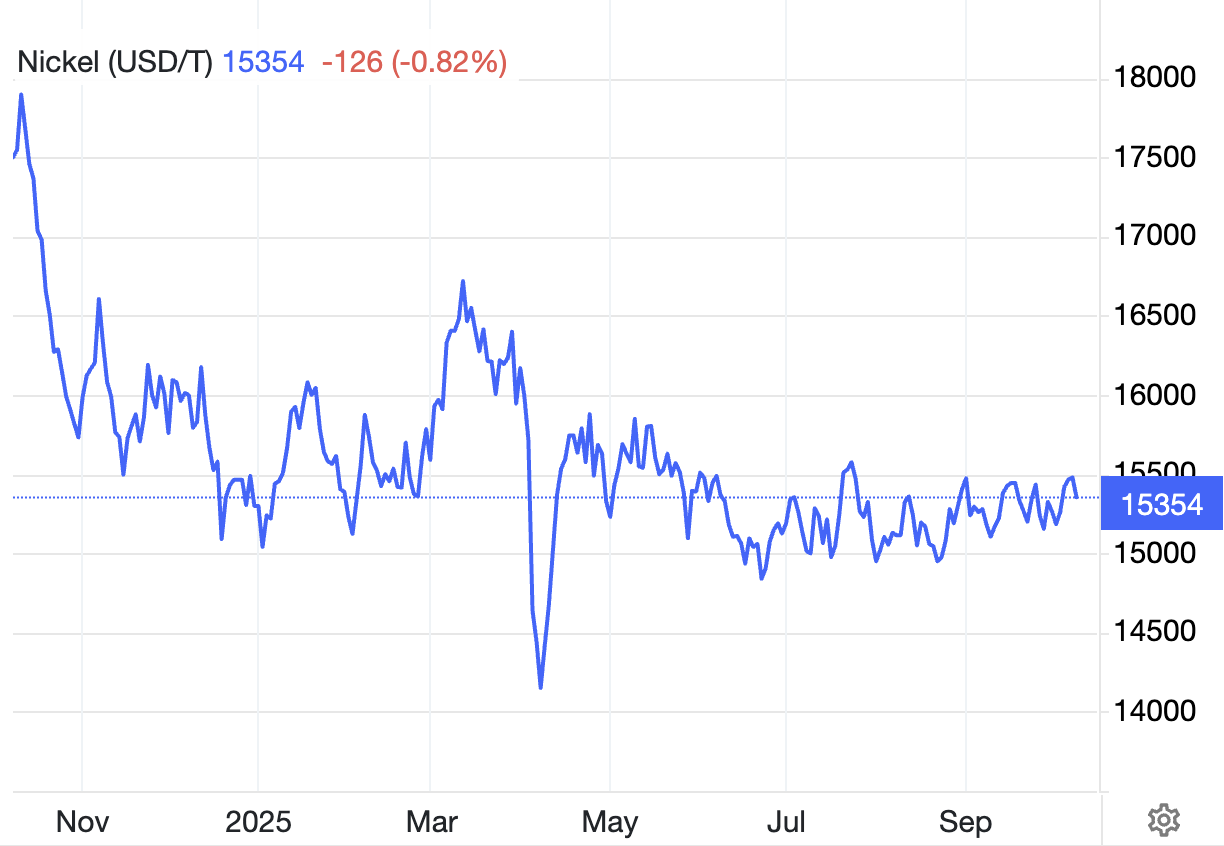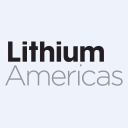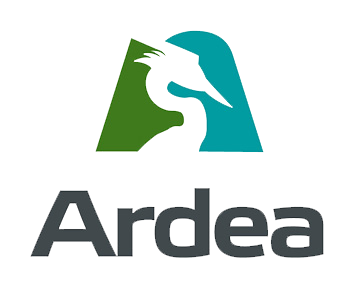Nickel Market at Inflection Point as Indonesia Signals Q1 2026 Tightness
.jpg)
Nickel breaks trading range; Indonesia tightens supply. Govt equity stakes drive 2-10x gains. Canada Nickel up 40% as investors position ahead of funding for Crawford project.
- Nickel prices are pushing against the top of their 3-4 month trading range ($15,000-$15,500), with brief breakouts to $15,600 suggesting potential upward movement as Chinese markets return from holiday; ore prices increased $0.50-$1.00 per tonne during the holiday period
- Indonesian government and industry representatives at nickel study group meetings indicated plans for more aggressive supply management through year-end and early 2026, with tightness expected in Q1 2026 due to forestry crackdowns and one-year licensing changes
- US government taking equity stakes in critical minerals projects (10% in Trilogy Metals, increased stake in Lithium Americas), triggering significant stock revaluations; companies receiving government support have seen 2-10x returns, with Canada expected to announce priority project lists
- Canada Nickel released positive drill results from Midlothian deposit showing consistently higher grades (0.29-0.30% nickel) than typical deposits; stock up 40% over past month as investors rotate from gold into critical minerals ahead of anticipated government funding
- BHP selling West Australian nickel assets with Glencore and Wyloo in due diligence, marking potential market bottom signal; limited nickel project advancement globally positions surviving companies for stronger competitive positioning
The critical minerals sector is experiencing a structural shift in how projects are financed and valued, driven by direct government intervention in strategic metal supply chains. Mark Selby, CEO of Canada Nickel, recently outlined how government equity participation is creating substantial revaluations in the sector, while nickel markets show technical signs of breaking out of a prolonged trading range.
The confluence of government funding, improving nickel fundamentals, and capital rotation from precious metals represents a potential inflection point for critical minerals companies. Selby noted observing "six $50 million plus funding announcements" within a few days, indicating renewed capital deployment after years of investor absence from the sector.
Nickel Price Dynamics and Near-Term Catalysts
Nickel prices have been range-bound between $15,000 and $15,500 per tonne for three to four months, with a slightly wider range over the past eight to nine months following tariff announcements in spring. However, recent price action suggests potential for a breakout, with prices briefly touching $15,600.

During China's week-long October holiday, ore prices increased by $0.50 to $1.00 per tonne despite reduced trading activity. Selby characterized this as supportive for nickel pricing, particularly as Chinese markets return to full operation. He stated,
"I think nickel might actually get interesting here for the next little bit. And I have said it many times like this fall is when we're going to see the first move."
The seasonal pattern typically sees Indonesian production increase during this period while Philippine output begins declining due to weather. However, Indonesian supply management policies may alter traditional seasonal dynamics.
Indonesian Supply Management Strategy
Indonesia now represents two-thirds of global nickel supply, making government policy critical to market balance. At recent International Nickel Study Group meetings, Indonesian government and industry representatives outlined more aggressive supply management intentions.
Key policy changes include reducing mining licenses from three-year to one-year terms and implementing forestry crackdowns that limit mining expansion. Selby reported that Indonesian representatives "were pointing to more tightness through seasonally" and "were really pointing to some tightness coming in the first quarter next year."
The Indonesian government's strategic shift reflects a desire to "extract more value from this limited resource," according to Selby's direct conversations with officials. He noted that "the grade decline in some of the material is quite substantive," suggesting resource quality concerns are driving supply discipline.
These policy changes align with broader resource nationalism trends where producing nations seek greater economic benefits from mineral extraction. For nickel markets accustomed to Indonesian supply growth, any sustained production constraints would materially impact supply-demand balances.
Government Funding as Market Catalyst
The United States government has moved beyond grants to direct equity participation in critical minerals projects. Recent examples include an increased equity stake in Lithium Americas as well as a 5% stake in their Thacker Pass JV project with General Motors, and a 10% stake in Trilogy Metals' polymetallic copper project in Alaska.
Stock market responses to government funding announcements have been substantial. Selby outlined:
"Lithium America since that announcement has more than doubled in a month. MP Materials has tripled in three months. They're the rare earth project that got a bunch of government funding in the summertime. The Metals Company has a couple three or four sets of good words from the US government, and that stock is up 10x since last December."
These revaluations reflect investor recognition that government support significantly de-risks project development and financing. Selby suggested investors should consider "which of those companies, which of those projects should get big direct government support" rather than "trying to buy in as the stock is doubling or tripling."
Canada is following the US approach but with additional strategic considerations. Under Prime Minister Mark Carney's positioning, critical minerals development represents a "massive big project reindustrialisation" opportunity similar to previous economic step-changes in Canadian history. Critical minerals spending will count toward Canada's NATO defence spending commitments, creating budgetary incentives for government support.
The Canadian government is developing priority project lists through fall, identifying large-scale, First Nations-supported, advanced-stage projects producing one or more critical minerals. Selby indicated that Canada Nickel's Crawford project "ticks the boxes" for inclusion on upcoming lists.
Government Strategy Evolution
Government approaches have evolved from passive funding programs to active project participation. Selby recounted that 15-18 months ago, US White House officials expressed frustration, asking "what do we need to do to start to see more mines and projects built in this country?"
The realisation that "talk isn't going to get it done" has driven governments toward equity stakes, credit facilities, and infrastructure commitments. This shift addresses the "stop-start momentum" that has historically killed project development during commodity cycles.
Canadian strategy under Carney focuses on reducing Chinese participation in critical mineral supply chains, developing domestic processing capacity, and positioning Canada's natural resource endowments as economic strengths in a less favourable US-Canada trade environment. Infrastructure development - roads, power, and supporting facilities - is explicitly part of the government commitment.
Canada Nickel Operational Updates
Canada Nickel released drill results from its Midlothian deposit, one of three large deposits (Reid, Mann West, and Midlothian) the company refers to as "three giants." Midlothian has shown consistently higher grades than typical nickel sulphide deposits, ranging from 0.29% to 0.30% nickel versus the more common 0.2% to 0.3% range.
"What's been interesting about this deposit is generally these deposits 0.2 to 0.3, you might get a few places where you've got some specific upgrading happening, but generally just by the nature of the rock that forms these deposits, that's the grade range. What's been interesting is Midlothian's been really at the upper end of that range, kind of 0.29 to 0.3% nickel."
The company plans to release a resource estimate for Midlothian before year-end. The deposit has a "bigger footprint than Crawford," the company's flagship project, while maintaining higher average grades.
Canada Nickel's stock has appreciated approximately 40% over the past month. Selby attributed this to "investors realising and getting a lot more smart, high net worth, longer-term investors literally rotating out of gold into critical mineral stories" as the government funding narrative and nickel market fundamentals align.
Sector Activity and Competitive Positioning
BHP's decision to sell its Western Australian nickel operations represents a potential contrarian indicator for nickel markets. Selby characterised BHP's nickel strategy as having "timed everything in nickel absolutely wrong," building a nickel sulphate plant based on incorrect premium assumptions, buying assets at peak prices, and now divesting at what may prove to be a market bottom.
Glencore and Andrew Forrest's Wyloo Metals are reportedly in due diligence on BHP's assets, according to the Australian Financial Review. Selby suggested that
"The fact that they're selling their West Australian nickel business once again is a pretty good bull signal that the market is about to turn."
Other nickel development activity remains limited. First Atlantic announced visual mineralization results from step-out drilling at its War Right deposit in Newfoundland, with assays pending. Ardea Resources released infill drilling results at its Goongarrie hub project in Australia, where higher-grade areas are emerging in advance of a feasibility study with Sumitomo Metal Mining and Mitsubishi. Selby noted that
"There's not many nickel projects progressing these days. China's done a good job of dampening enthusiasm for nickel, which is what they want. And those of us who can survive are going to come out the other side that much better."
Capital Rotation Patterns
Gold's approach toward $4,000 per ounce is attracting generalist investors back to mining after a decade-long absence from the sector. Selby observed that
"To really have a massive re-rate and see the kind of valuations that we saw back in the early 2010s, back in the mid-2000s, you need that generalist money to come back in the story."
The pattern follows previous cycles where precious metals outperformance draws capital into mining broadly, with investors subsequently seeking value in less-appreciated commodities. Selby stated:
"Once people start making money in that sector, they can reinvest their profits in stuff that hasn't run yet. There's a follow-on benefit that we should start to see big time in the rest of the other sectors."
This rotation is particularly relevant for critical minerals companies that have underperformed during the recent precious metals rally. With gold stocks trading at elevated valuations, investors are examining "these other commodities, these other stocks in those commodities look pretty undervalued."
Strategic Implications
The combination of government funding commitments, Indonesian supply management, technical nickel price breakout potential, and capital rotation creates multiple supportive factors for critical minerals companies. Government equity participation fundamentally changes project risk profiles and financing dynamics, while supply-side discipline in Indonesia addresses the oversupply conditions that have suppressed nickel prices.
For investors, the key consideration is positioning ahead of government funding announcements rather than after stock revaluations have occurred. Projects meeting government criteria—large-scale, advanced-stage, First Nations-supported, producing strategic minerals—represent the highest probability for funding support.
The nickel market's technical setup, with prices testing range resistance as Chinese markets return and Indonesian supply constraints emerge, suggests potential for price appreciation through year-end and into 2026. Companies with advanced projects in stable jurisdictions, strong balance sheets to withstand market cycles, and alignment with government strategic priorities are best positioned to benefit from converging positive factors in the critical minerals sector.
Key Takeaways
Government intervention through equity participation is fundamentally altering critical minerals project economics and valuations, with companies receiving support experiencing 2-10x stock appreciation. Indonesian supply management policies are tightening nickel markets entering 2026, with Q1 tightness anticipated from licensing delays and forestry restrictions. Nickel prices are testing the top of multi-month trading ranges as Chinese markets return from holiday, with seasonal and policy factors supporting potential breakouts. Capital rotation from overvalued gold stocks into underappreciated critical minerals is underway as generalist investors return to mining. Companies with advanced, large-scale projects in stable jurisdictions aligned with government strategic priorities offer asymmetric upside ahead of funding announcements rather than after stock revaluations occur.
TL;DR:
Government equity stakes in critical minerals projects are driving 2-10x stock revaluations (Lithium Americas doubled in a month, MP Materials tripled in three months) as strategic funding accelerates project de-risking. Nickel markets are positioned for potential breakout from 3-4 month trading range as Indonesian supply management tightens and Chinese demand returns post-holiday. Canada Nickel's 40% stock appreciation reflects investor positioning ahead of anticipated government funding for projects like Crawford that meet strategic criteria. Capital rotation from gold into critical minerals creates an opportunity to invest in undervalued assets before government announcements rather than chasing already-revalued stocks.
FAQ's (AI Generated)
Analyst's Notes




Subscribe to Our Channel
Stay Informed




























